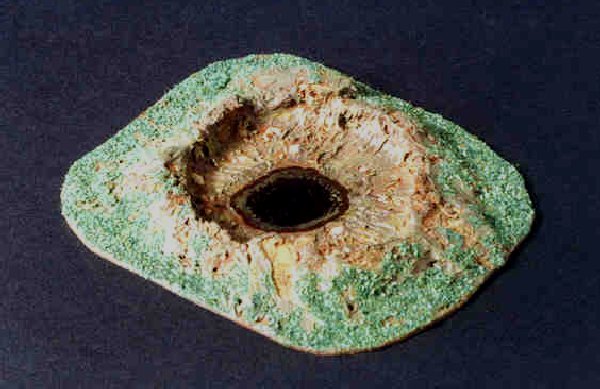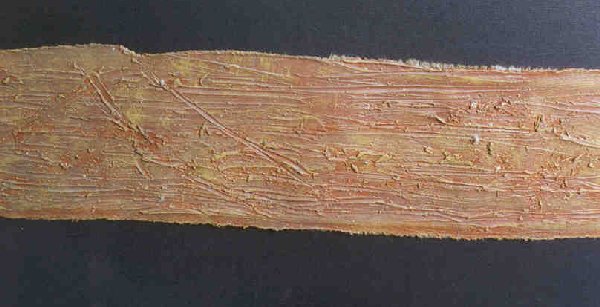Get some cloth. I used thickish plain cotton. Cut it into strips, curves, forks, s-bends and whatever other road shapes you want to make, all of the same width.
Next, pipe a load of mastic onto the cloth, and spread it around to cover all the cloth reasonably evenly. Sprinkle some of the finer particles of cat litter along the roads.
Leave the result to dry for a bit, twenty minutes to half an hour is good. If you don't wait a while, you'll find that sculpting the surface is very tricky, because the mastic is very sticky when it first comes out into the air, and I found it to be near unworkable when in this state.
Once the mastic has calmed down a bit, sculpt/texture the surface. I used a matchstick for most of the work. Make sure that the cat litter dust is worked into the surface, not just lying on it. In the example stretch of road pictured, you can see where a cart has made a two-point turn (on the left of the picture). If you are only going to use the road for modern warfare, then you might want to use tank tracks and the like to make impressions. This kind of road is useful for almost all periods, however, so you may want to refrain from this. Dirt roads were the norm until very recently, and pictures I have seen of metalled roads in wartime often show them to be covered with mud and dust.
Paint the road with a brown acrylic wash, to give some variety to the colour of the brown mastic. Once this wash is dry, dry-brush with a big cheap brush, in a light sandy colour. You may want to trim the edge to be very neat. The mastic will stop the cloth from fraying, so you can do this. I chose not to, however, as I wanted the road to have a bit of a wobbly edge to it. I used dull green cloth, and you can just see in the picture some untrimmed edge to the cloth sticking out, which looks a bit like grass growing on the verges, and it softens the edge of the road.
The final result is a flexible road, which has a pleasant amount of weight to it. It will flop under its own weight to lie properly on the table, despite whatever bumps it is placed over. If it gets a bit scrunched in storage, don't panic. Lie it out flat and it will soon recover its shape.
Quick, easy, transportable, durable, versatile, cheap.
One correspondent told me that he had put grass flock down the centre of his roads, for a "rural" look. A word of caution here. Many people think of roads with grass growing up the centre as an old-fashioned sort. One often sees these used as locations in period films. These are a modern phenomenon. In the days of motor transport, the wheels of cars and lorries go either side of the untrampled middle, where grass grows. In the days of horse and foot transport, the centre of the road was usually the most trampled part. Most vehicles were drawn by a single horse in the centre.

The photograph has not been kind to this. In reality, it looks a fair bit more three-dimensional. The base of this crater is cut from a floppy plastic floor tile - a sort of linoleum. The height of the crater sides is built up from cork and whatever else came to hand. The whole was then covered with lovely brown acrylic mastic, and sculpted into a crater shape. The bottom of the crater was made very flat, by dipping a finger in water and using the tip to smooth this area. Away from this area, the rounded butt of a paint brush was used to create radial lines.
The earthy bits got a brown wash, then dry brushed sand, and flocked with grass flock. The smooth area at the bottom was painted to look like a murky puddle, and given a gloss varnish finish. Viewed from the right angle, the puddle reflects the light like the surface of flat standing water.
I hope that you don't mind my putting roads and craters on one page. This section is getting rather large, and they both use mastic.
BACK TO SCENERY MENU BACK TO MODELLING MENU
Click here to go back to the home page



